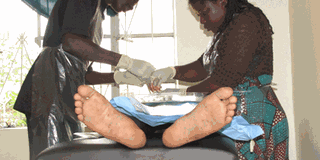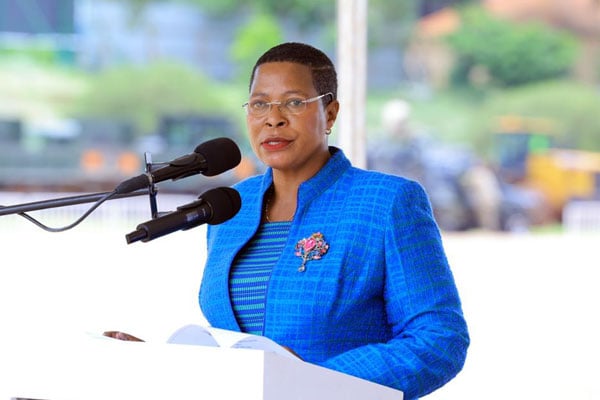150,000 to be circumcised in north

A man undergoes circumcision at Ober Health Centre in Lira District last week. PHOTO BY DIDAS KISEMBO.
What you need to know:
The target. As health workers explore different means of fighting HIV/Aids in Uganda. Government has organised various camps in northern Uganda as it targets to circumcise at least 150,000 males by September.
Lira:
It is midday and at Ober Health Centre in Lira District, eight youthful men sit on a wooden bench chatting in hushed tones.
“ManU will win the premier league this time we have a tough coach,” quips one, with a grin.
It is remarkable considering that only 10 metres across the room from where they are sitting, is the surgical ward, where three of their colleagues are being circumcised. The eight are waiting for their turn.
They however hum in low tones, smiling from time to time. After 10 minutes, the theatre door opens and a stout-bearded man calls out a name – Robert Opio.
A tall, lanky fellow leaps up from amongst the group and strolls with confidence in the room with a show of courage for a practice that is dreaded by many men in Uganda.
“I did this mainly because most of my friends have been circumcised,” calmly explains 26-year-old Opio after the 15 minutes procedure. “It is not painful; the fear is all in the head,” says Opio of the secret to the courage he boosts.
Opio is participating in a circumcision camp that has been organised by the government in northern Uganda to curb the rising cases of HIV.
Different health centres in the north have so far registered a high turnout for the exercise; with most averaging 70 male circumcisions whenever the camps are held.
“On a good day, we even reach 100, especially when mobilisation takes place,” explains Hilary Okello, chief circumcision surgeon at Ober Health Centre.
With condoms failing to serve their prime purpose, and abstinence not easy to monitor, district health authorities in northern Uganda have embarked on an ambitious mass male circumcision drive as a solution. “We have reached a point where we strongly believe that safe male circumcision is the way to go, transmission can be reduced to below 5 per cent from 8 per cent,” notes Dr Paul Onek, the District Health Officer.
“We enlisted the assistance of Plan Uganda through its USAID/ Northern Uganda Health Integration to Enhance Services (NU-HITES) project to provide technical and logistical support,” he says.
So far, according to Dr Onek, the project has trained more personnel to aid circumcision as well as provide circumcision kits.
The exercise being undertaken in 15 districts targets to circumcise 150,000 men by September.
Twenty five sites across the region have been identified to host circumcision camps, currently running on a weekly basis.
Health officers at different centres across the region are worried over the increasing number of new cases of HIV registered over the past five years.
At Anyeke Health Centre III for example, cases of HIV shot from 562 to 635 driving the total population of people on ARV treatments from 5,040 to 6,681.
“Here in Oyam, the prevalence has gone as high as eight per cent. The queues are getting longer each month,” says Dr Moses Nassim of Anyeke Health Centre III.
“At Agwata we register 25 new cases on average each month and that is for those that are coming to the centre to test,” says Moses Okello, the officer in-charge of Agwate Health Centre in Dokolo District.
Statistics from the Uganda Demographic and Health Survey conducted in 2006 revealed that only a quarter of the male population in Uganda is circumcised.
It also showed HIV prevalence being higher among uncircumcised males at 7 per cent compared to those circumcised at 4.5 per cent.




